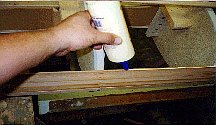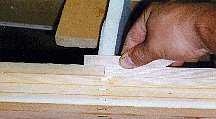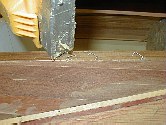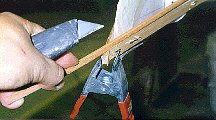 |
One
way to start is to attach the strips alternately on either side until the mold assembly stiffens
(5 courses of strips or so).
Note that a groove must be cut into the cove of the opposite strip so that the intersecting strip
can be fully seated. Don't spend much time on this if you plan to attach a stem band later on. |
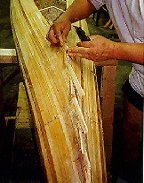 |
This
alternating style is the simplest. The first strip of a new row sticks out and the counterpart is
shaved to fit the angle. The next row is done the same way except the sequence of the strips is
reversed and so on...
Because of this shallow 'dovetailing', the stem is very strong.
This style can be carried well onto the bottom. A faster method is better suited to finish the flatter
parts of the hull. |
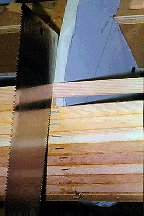 |
When
two shorter strips meet somewhere in the middle of the kayak (and most will), prepare both strips
by shaping the stem ends first. Dry-fit them into position until they seat properly ( at
this point, both are longer than needed). Pull both of them out and run a bead of glue under the
first strip. Staple it down from the stem towards the middle and cut it in the center of the chosen
station.
Do the second strip the same way from the other tip and when you get to the station, trim off the
excess as in the picture. A bit of practice will make for no-gap joints.
In flatter areas, these joints needn't fall directly on the rim of the stations. This will stagger
the breaks and lets you use odd lengths and leftovers. |


